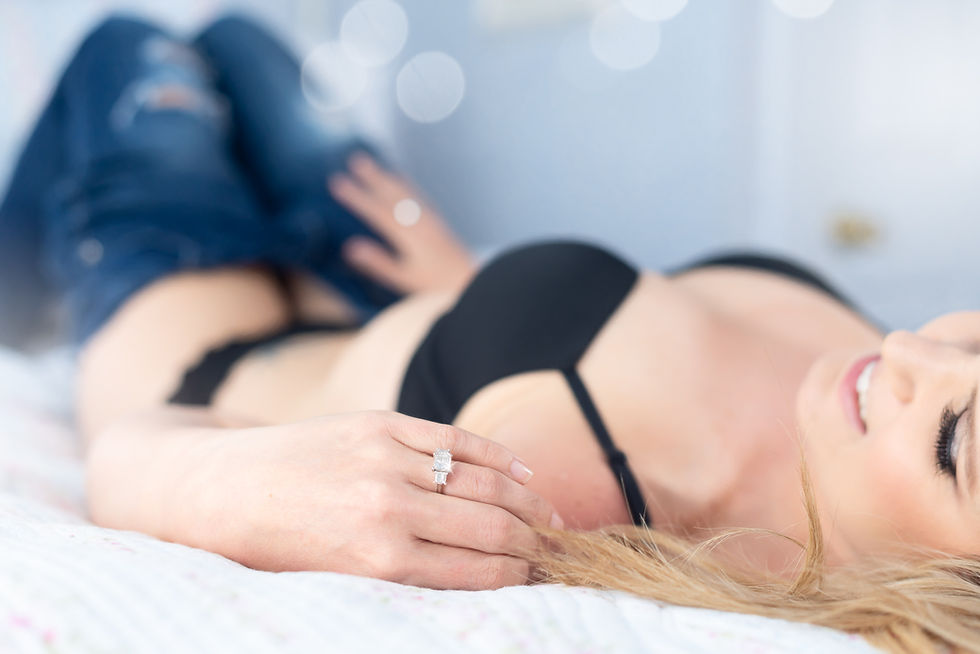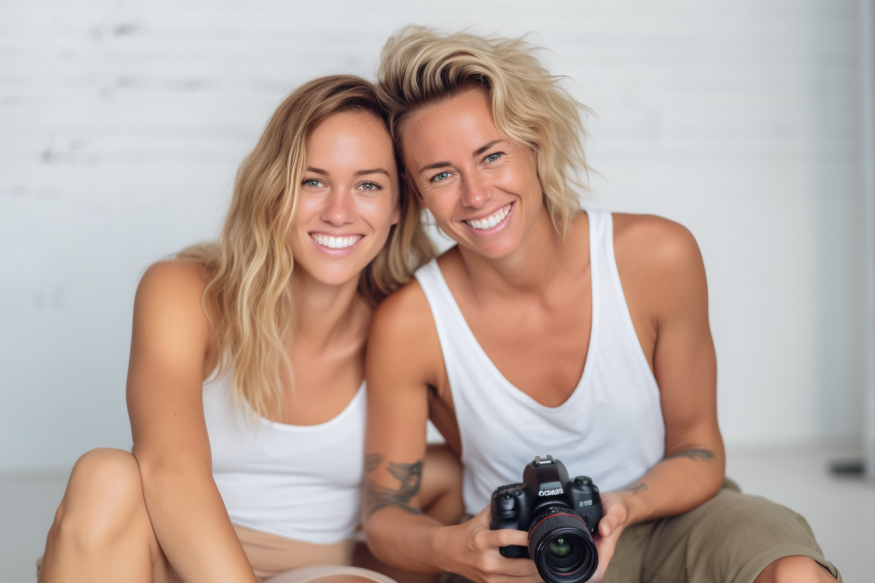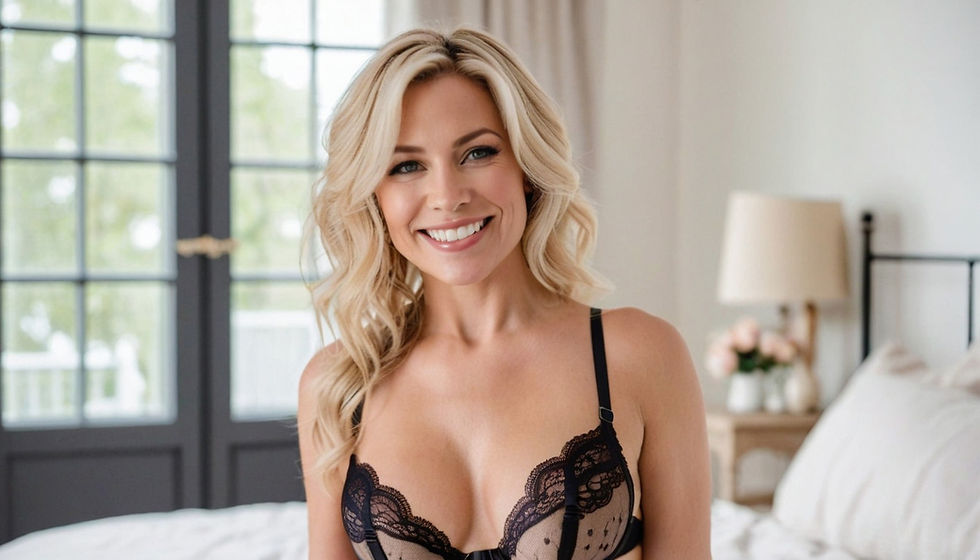Why Is Boudoir Photography So Popular?
- Mike Cassidy

- Jun 17, 2023
- 9 min read
Updated: Sep 13, 2024

Boudoir photography is gaining widespread attention, appearing everywhere from social media feeds to magazine spreads. This intimate genre has blossomed into a globally celebrated art form, intriguing many with its blend of personal vulnerability and artistic expression.
But is it just about capturing sensuality, or is there something deeper at play? As someone deeply immersed in this art, I'd like to unveil the essence of boudoir photography. It's about exploring vulnerability, celebrating individuality, and empowering oneself. The camera becomes a transformative tool, capturing a journey toward self-love and acceptance.
Far from being a mere trend, boudoir photography has the power to redefine perceptions of beauty and shatter stereotypes. Each image tells a story, preserves an emotion, and affirms confidence. Its allure resonates with a global audience eager to engage with authenticity, vulnerability, and beauty.
As we dive into the nuances of boudoir photography's rising popularity, remember that it's more than just taking pictures—it's an intimate experience and an ongoing conversation about self-expression, femininity, and body positivity. Let's embark on this exploration together.

The History and Evolution of Boudoir Photography
Step back in time with me for a moment, to the birth of photography itself. It's hard to imagine now, but there was a time when this art form we take for granted was fresh, new, and revolutionary. Boudoir, as a term, comes from the French "bouder," meaning to sulk, referring to a lady's private dressing room or bedroom. However, boudoir photography, as we understand it today, is a considerably more recent innovation.
In the Victorian era, boudoir-like images began to emerge, but they were cloaked in secrecy and viewed as risqué or even immoral. The development of the daguerreotype in the 19th century, the first publicly available photographic process, provided an avenue for this fledgling art form, though it remained strictly underground.
Fast forward to the mid-20th century, when photography became more democratized, and societal attitudes started to shift. There was still an air of secrecy around boudoir-style imagery, but the seeds of the genre we know today were beginning to sprout. It was a slow evolution, born of changing cultural attitudes and the growth of feminism, which began to break down some of the traditional barriers and taboos around female sexuality and the female form.
It was really the dawn of the digital age, however, that heralded the boudoir revolution. The advent of digital photography and the Internet allowed images to be shared more freely and widely, and photographers to experiment and innovate with less financial and logistical constraints. As technology advanced, so too did the art of boudoir photography.
In the last decade, there's been an astonishing surge in the popularity of boudoir. This can be attributed to numerous factors—increased accessibility, the rise of social media, shifting societal attitudes—but above all, the increasing desire of women worldwide to celebrate their bodies, their sexuality, and their individuality.
What's particularly fascinating is the transformation in the perception of boudoir photography over the years. From an art shrouded in secrecy and scandal, it's now celebrated as a powerful tool for empowerment and self-expression. It's no longer seen merely as images for a lover or partner, but as a personal journey, a gift of self-love and confidence that a woman gives to herself.
As we continue on this journey, it's important to recognize that the rise of boudoir photography is not a passing fad. It is the evolution of a society moving towards embracing individualism, self-love, and a broader definition of beauty. And as we look to the future, it's an art form that promises to evolve and adapt, just as it has done throughout history.

The Psychological Aspects of Boudoir Photography
In the heart of boudoir photography lies an intimate exploration of oneself, an uncovering of layers, an unveiling of vulnerabilities. It's not just about the sensuous or erotic shots; it's a therapeutic encounter, a journey of self-discovery and affirmation. Therein lies the first psychological aspect of this intriguing genre: the art of self-discovery.
With every photograph taken, with every click of the shutter, there is an opportunity for the subject to dig deeper into themselves, to peel back layers of self-doubt or negative self-perception. This process can be transformative, and I've witnessed countless women emerge from their sessions with a newfound respect and love for their bodies and their identities.
While society is progressing, there is no denying that we are still under the influence of age-old stereotypes and notions of beauty. And this is where a boudoir shoot steps in, challenging these preconceived notions, showcasing beauty in diversity, and embracing all body types. In essence, it promotes body positivity, giving women the confidence to embrace their bodies just as they are.
Just as every human is unique, so too is every boudoir session. It is a reflection of the individual, their journey, their emotions, their inner strength, and their sense of self. This personalization and the subsequent realization of one's worth, beauty, and strength provide a powerful boost to self-confidence.
The transformative journey that boudoir photography offers is often extended into the personal relationships of the participants. There are countless instances where these photographic experiences have rekindled sparks in relationships or allowed the subjects to open up about their vulnerabilities, further deepening their bonds with their partners.
Of course, the process doesn't come without its anxieties and apprehensions. Stripping down, both physically and emotionally, can be daunting. But herein lies another psychological layer of boudoir photography—the conquering of fears. The act of facing one's fears and insecurities, and still going ahead with the shoot, is a liberating experience. It speaks volumes about the human spirit and its indomitable will to overcome.
When we delve into the psychology behind the popularity of boudoir photography, we realize that it's not just a passing trend or a fad; it's a means of expression, a therapeutic tool, and a celebration of the human body and spirit. It's about empowerment, body positivity, acceptance, and self-love—themes that are more important now than ever before. As we continue to explore the facets of boudoir photography, let us remember the profound psychological impact this art form can have.

The Artistic Perspective of Boudoir Photography
From an artistic lens, boudoir photography is an incredible platform for creativity. Each session is a unique tapestry woven with strands of light, shadow, emotion, personality, and beauty. In this realm, the boudoir photographer is part artist, part storyteller, part guide, with each click of the shutter becoming a brush stroke on a living canvas.
Lighting, to me, is like the soul of a boudoir image. It's a key element that can create a mood, bring out a detail, or set a whole narrative in motion. It's about capturing the play of shadows, the soft glow on skin, the way light dances in the eyes or traces the contours of a body. This understanding and manipulation of light and shadow are what give boudoir photos their depth, texture, and mood.
The choice of setting and props adds another layer to the creative process. Be it a bedroom, a vintage set, or an outdoor location, the setting can set the tone for the session, complement the personality of the subject, and add richness to the composition. The same goes for props. From the sultry to the subtle, they can serve as powerful tools to evoke emotion, stimulate intrigue, or accentuate beauty.
Boudoir photography thrives on the concept of "less is more." It isn't about over-the-top glamour or opulence. It's about the simplicity of a gaze, the elegance of a silhouette, the intimacy of a touch. It's a genre that revels in subtlety, yet speaks volumes.
Art is subjective, and so is beauty. And that's the beauty of boudoir—it's personal, unique, and diverse. Every subject brings their own story, their own beauty, their own personality to the frame. As the person behind the lens, my role is to guide, to observe, and to capture that essence in the most beautiful, authentic, and creative way possible.
In this world of boudoir photography, we create not just images but art. Art that tells a story, that stirs emotion, that challenges norms, that empowers and uplifts. And therein lies its magnetism. It's not just about the final picture; it's about the artistic journey that leads to it—the vision, the creativity, the emotional connection, the telling of a story. It's this artistic integrity that breathes life into each image and is a testament to why boudoir photography resonates with so many.

Social and Cultural Factors Driving the Popularity
In our digital age, social media plays an integral role in shaping trends, opinions, and movements. It's no surprise that it has significantly contributed to the boom of boudoir photography. Platforms like Instagram, Pinterest, and Facebook serve as windows into the world of boudoir, showcasing the diversity, the creativity, and the empowerment that this genre offers. These platforms not only inspire but also create a community, a shared space for people to connect, discuss, and celebrate the art of boudoir.
But it's not just the power of social media at play here. There's a significant shift in societal attitudes that has fueled the rise of boudoir photography. In the last few years body positivity, self-love, and individual expression are increasingly being embraced and promoted. Women across the world are seeking ways to celebrate their bodies, their femininity, their beauty—on their own terms. Boudoir photography offers this platform, a space where stereotypes are shattered, and real, diverse beauty is celebrated.
Celebrities and influencers too have played a part in this surge of popularity. Their public endorsement of boudoir sessions, their openness in sharing their experiences, and the stunning images they share have a ripple effect, inspiring their followers to explore this avenue of self-expression and empowerment.
On a broader cultural level, we're seeing a significant shift. The traditional taboos around female sexuality and nudity are being challenged, and there's a growing acceptance and celebration of the female form in all its glory. Boudoir photography, with its emphasis on empowerment, authenticity, and celebration of the human body, aligns perfectly with this cultural shift.
There's also an element of rebellion, of defying the norms, and of reclaiming one's body and beauty. It's a counter-narrative to the airbrushed, size-zero ideals that have long dominated media representations of beauty. In a world where unrealistic beauty standards are increasingly being questioned, boudoir stands as a testament to real, diverse, authentic beauty.
In essence, the rise of boudoir photography can be seen as a reflection of broader societal and cultural shifts—a move towards acceptance, diversity, and individual empowerment. It's a celebration of the human body, of beauty in all its forms, of individual narratives. The popularity of boudoir photography, then, is not just a trend, but a mirror to our evolving society. As we journey through this exploration, it becomes clear that boudoir photography is more than an art form—it's a social and cultural phenomenon.

Future Trends in Boudoir Photography
As we peer into the future of boudoir photography, it's intriguing to imagine the potential trends and shifts in the horizon. While it's impossible to predict with absolute certainty, it's still an exciting exploration, built on the patterns observed and the lessons learned from the past and present.
The increasing inclusivity within boudoir photography is a trend likely to continue and strengthen. More and more, we are seeing the boundaries of this genre being expanded to include all bodies, genders, ages, and identities. As societal attitudes towards body positivity, diversity, and inclusion continue to evolve, we can expect to see even more representation and diversity in boudoir photography.
Technology will also undeniably play a significant role in shaping the future of this genre. The integration of virtual reality, 3D photography, and augmented reality might redefine the experience of a boudoir shoot and how the final images are consumed. These technological advancements may allow for more immersive and interactive sessions, transforming the way we approach boudoir photography.
Sustainability is another key trend impacting various industries, and photography is no exception. From the materials used in studio settings to the digital platforms used for sharing images, sustainability is likely to become a significant consideration in boudoir photography. Practices that minimize the environmental footprint of a shoot could become the norm.
As the popularity of boudoir photography continues to grow, so too will its integration with other genres and artistic mediums. We might see a blend of boudoir with other forms of art such as painting, sculpture, or digital art. This intersection of genres can lead to new creative expressions, pushing the boundaries of what boudoir photography can be.
While we can speculate on the future trends of boudoir photography, one thing remains certain: the core essence of this genre—empowerment, self-expression, and the celebration of the human form—will continue to resonate. Boudoir photography is more than just a genre; it's a movement, a statement, and an art form. It's a journey of self-love, a celebration of diversity, and a testament to the strength of the human spirit. As we venture into the future, this essence will undoubtedly remain at the heart of boudoir photography, guiding its evolution and ensuring its continued popularity.

Conclusion
Boudoir photography's popularity is more than a passing trend; it's a testament to its profound impact on individuals and society. It has evolved into an art form and movement that celebrates self-expression, empowerment, and diverse beauty.
At its heart, boudoir photography is a personal journey of self-discovery. It offers a therapeutic experience where individuals can embrace vulnerability, celebrate their bodies, and rewrite their narratives. This process nurtures self-confidence and fosters personal transformation.
The rise of boudoir photography aligns with broader cultural shifts toward body positivity, self-love, and challenging traditional beauty standards. It serves as a rebellion against societal norms, a reclaiming of individuality, and a celebration of authenticity.
Looking ahead, boudoir photography promises to continue embracing inclusivity and technological advancements. Yet, its core essence remains unchanged—a celebration of the human spirit and a testament to the power of embracing one's unique beauty.



